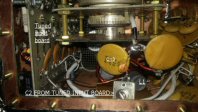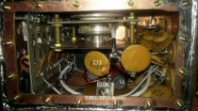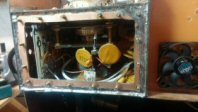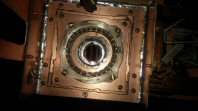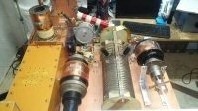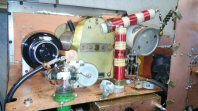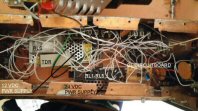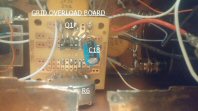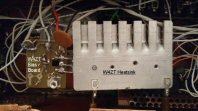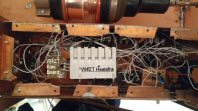Hello to all, when I started to build my very first home brew amplifier, I needed a cabinet to build the amplifier in, and they are expensive. I am one who thinks "out of the box" my first homebrew amplifier was using a 4-1000A and it was built with a collection of parts another ham had, but had never built the amplifier, just collected the parts. He had just about everything for the RF deck including the tuning network, which was the old plug in link coupled coils. There were coils for 80-10 meters, but you have to unplug one set and plug in another to change bands. I first went to the local power company and purchased a pull out transformer, and they also had a nice big oil filled capacitor as well. So then I needed a cabinet. I had the chassis for the tube, which was just a bottom chassis, no top, sides or front. I was driving to town one day and saw a man working in his yard and he had a bunch of washers, dryers and other appliances scattered around him. I drove in and asked if he wanted to get rid of any of them, he said he was just taking out any usable parts and that I could have any of the ones he was finished with, so I looked around. I settled on a top loading wash machine cabinet as this would be great for changing the link coupled coils. It was a good starting project and the cabinet worked great as I afforded lots of room inside for that transformer and then the chassis enough head room for the link coupling. It worked great, had 6000 VDC from the full wave bridge capacitor input supply, so the 4-1000 did fine, 1500 out on all bands. It became known as the washing machine with the group of guys I normally qso'd with at that time, if they had trouble hearing me they would tell me to turn on my washing machine HI HI. So from that time on I was always able to come up with a cabinet I needed for a project for either trade, free, or cheap.
Later after I got tired of changing link coils in the 4-1000 all the time I was able to do a trade for a 4CX1500B and socket. This I wanted to put in a different cabinet so as to not disable the 4-1000, so again I went to the power company and was able to get the transformer I am presently using. I started looking for a cabinet and a ham friend had the power supply cabinet I am presently using, I was told it had been the power supply cabinet for the city of Medford Oregon's police AM transmitter. It is nice has doors on each side that open and nice wide roller wheels. So now I needed a cabinet for the RF deck. I was at a friends house one day, he was a fixit guy, worked on most anything, later he also became a ham. I saw this nice Litton restaurant microwave oven, mostly all stainless steel, sitting on a shelf in his shop, asked about it, he said it was not repairable and they didn't want it back, so I asked what he wanted for it, he gave to me free. I removed the door and took it over to a friends shop where he had a cutting torch as at the time I did not have one, I cut out the oven compartment leaving just the bottom and front ring(after removing the door and cutting out the oven comparmnet all you see from the front is a hole where the oven cooking compartment was like a square ring). The cover was one piece the top and sides are stainless steel one piece with screws only at the bottom of the back and finger stock for connecting to the bottom and front of the cabinet. At this point I had a pretty poor looking cabinet, I had removed the oven door and cut out the oven leaving just about an inch of metal around where the oven compartment had been. If you look at the second photo in the series on this page you can see the back of the cabinet front at the top of the photo, you can see the raged cut edges of the original stainless cabinet. I made an aluminum front plate, and a steel shelf inside that stood up on spacers about 2 inches, inside the cabinet. I used the cabinet this way o build my 4CX1500B RF deck. Construction was similar to my existing, except no copper, all was steel. The 1500B worked well but it was a pull-out tube and in time finally died from a cathode to grid short.
I then came across a couple of medical pull-out 8877's and I built another RF deck with one of them, but did not want to dismantle my 1500B deck as I hoped I could come across another 1500B later. I had a microwave oven of my own that had died and used it to build the 8877 RF deck, it worked well, but have always disliked the noise from the cooling air needed on a full power amplifier. I used that existing 3000 VDC power supply that I built for the 4CX1500B amp.
I saw an article by PA3CEG showing converting the cooling structure of a GS35B for liquid cooling. This is very good as the cooling structure is bolted to the tube allowing you to convert it and then using it on any tube. I found a source where I was able to purchase three new tubes and one cooling structure. I removed the fins from the anode cooling structure and built the liquid cooling structure, using a piece of copper pipe for the outer cylinder and the original cylinder, had two doughnut shaped pieces of brass cut for me at a machine shop, then did the rest my self. when finished I plugged one tubing connection and applied about 30 psi of air to the other tubing connection, then putting the cooling structure into a bucket of water and finding any air leaks, then sealing the leaks one at a time until it was totally air tight. I decided this was a better option then finding another 4CX1500B for my old RF deck so decided to use it for the new GS35B liquid(Transformer oil) cooled amplifier. I then redid my chassis construction of the cabinet. I found I could get double and single sided circuit board on eBay at a good price so got enough to laminate on top of the front and top of the existing cabinet structure and then build the 3 chassis for the tube, control, and junction box with copper walls and tops and bottoms, all the seals soldered together except the access covers which used either brass screws or brass screws
and brass nuts. This made a much better RF tight construction. Once totally finished I found the amplifier to work very well, I can get 1200-1500 watts out on all bands. It is very stable and I have checked the anode temperature on various occasions using one of those IR temperature guns, it has never gone over 120 degrees on the anode and less on the seals that are rated at a much higher temperature. I used the same 3000 VDC power supply I had already. That is about all I can comment on, if you ever want more info write me an email at k7vic@k7vic.com 73 es hpe to cul dit dit.
|


